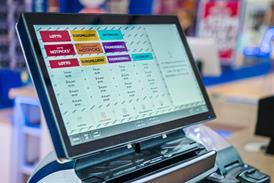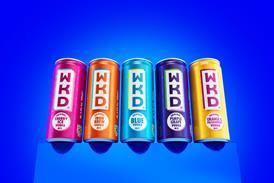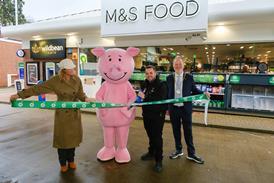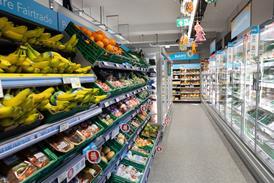Unfurl those flags as we’re about to get patriotic all over again, which is great news for the cake market and for the nation’s shopkeepers
Last year the country underwent the kind of patriotic fervour usually reserved for the four-year ritual when we manage to convince ourselves that we’re going to win the Football World Cup - no, really, we are - with a big British knees-up for the Royal Wedding. This year, with the Olympics and the Queen’s Diamond Jubilee, we look set to do it all again.
According to Premier category strategy manager for bakery Erika Reid, the country will be ‘swept with patriotism’ and, it seems, one of the areas to benefit will be the cakes and biscuits market.
According to UB customer marketing manager Nick Stuart, the outlook is good, if the Royal Wedding is anything to go by. “Sales figures show that the Royal Wedding lifted sales for the total cake market by 6% last year, equating to almost £5m, demonstrating just how big an opportunity social events such as the Queen’s Diamond Jubilee can be for retailers.”
Stuart says that the McVitie’s Royal Wedding commemorative biscuits tin resulted in £1.4m-worth of incremental sales within a matter of weeks. The company will be marking the Queen’s Diamond Jubilee again this year, although it is not yet ready to say what with.
In a bid to cash in on British fever, Premier’s Mr Kipling has added a British Sweet Shop Collection to its Inspirations range, including Fruit Salad Mini Battenburgs and Pineapple Slices, with the latter available in snap packs.
Away from all this patriotic fervour, it’s down to new occasions and new consumers to drive sales. Within cakes this can be tricky, says Reid. “The traditional cake-buying consumer is a little older than the total population, and generally consumes cake during a more formal sit-down occasion.”
Blurring the line between cakes and other categories such as confectionery can be a route to growth. “It is essential that the category continues to innovate with new formats and packaging to ensure it fulfils evolving consumer needs,” says Reid.
She says that the company’s snap-pack format, launched last year, has driven Mr Kipling’s appeal among younger families, and the launch of Cadbury Boost Bar attracted pre-family shoppers, more familiar to the confectionery buyer. The company is hoping to repeat this success with Double Decker Cake Bar later this year.
This theme of exploring new occasions is also key in the biscuits category, according to Burton’s Biscuits category and activation controller David Costello. “The secret is to create new occasions, or appeal to people in households who are not heavy biscuits eaters. The launch of breakfast biscuit Belvita really opened up that part of the marketplace.”
This tapping into new occasions is at the heart of a lot of new product innovation and will be the key driver, according to Costello, of future excitement in the category. “The beauty about biscuits,” he says, “is that consumption is based around ritual - it’s very habitual. The good thing is that when you can untap new consumers and usages it becomes habit. But it also means the market is slower.”
Apparently, there is a huge gap where people fall out of the biscuit category. Says Costello: “Young people switch out of biscuits at about 17. When they’re kids they are very into biscuits, but then go through a confectionery stage and are into more contemporary products. At about 45 they come back in.
“We have to try to appeal to that 17-45 group to pull new customers in. If manufacturers can identify formats that appeal to the occasion usage of that age group, it’ll create excitement. By offering a more contemporary format it will brighten up the fixture and add appeal.”
He says that the launch of biscuit pouches has gone some way to address this, but it’ll take time because consumers of biscuits are very traditional. “And consumers often don’t know what they need for a particular occasion until it comes along.”
Says Costello: “The big thing about NPD and biscuits is that anything that helps the category will add penetration. Biscuits penetration is very high - about 98% of households buy biscuits. But only 29% of snacking occasions are currently covered by biscuits, which leaves a 71% potential.”
Costello says that the recession is having a positive impact on biscuit buying - prompting people to buy biscuits more frequently and more locally. “Burton’s has really benefited from this - we’ve seen a 19% rise in sales of Jammie Dodgers, and Cadbury Christmas Biscuits saw a 30% rise in sales. Plus we’ve added £5m to Maryland. And in the coming months you’ll see more innovation from Burton’s.”
Stuart says that this flourishing in the face of hard times is offering great potential to the category: “Typically, biscuits are one of the last areas that people look to cut back on, as they are seen as a relatively inexpensive treat. Given the fact that people are potentially more likely to stay in and treat themselves, rather than eat out in restaurants, the number of formal occasions are decreasing and the snacking occasion is becoming even more relevant in the home.”
He says that pricemarked packs can be key to highlighting the great value of biscuits: “A recent test with pricemarked packs generated a 13% increase in retail sales value.”
At the moment McVitie’s packs include a Dunk Time promotion, encouraging consumers to enjoy their tea with a McVitie’s biscuit by giving away branded mugs in conjunction with its VIP Club loyalty scheme. Other news from McVitie’s surrounds its Quirks brand, which is currently being advertised on TV for five weeks. Also Jacob’s Club and McVitie’s Penguin have new variants: Honeycomb flavour for Club and Toffee for the Penguin bar.
On display
With all this activity taking place, Reid says that retailers need to start thinking about the way in which they merchandise their cakes and biscuits fixture. “It’s more important than ever that retailers merchandise their cake fixture by occasion, as this allows the shopper to find what they want more easily. It also allows the retailer to highlight emerging occasions like sharing.”
She also points out that retailers should remember that some cakes can fulfil a dual function. “For example, a large chocolate cake can be consumed at both a teatime occasion or for a celebration.” She suggests that at least half the fixture needs to be allocated to large teatime cakes and small teatime cakes. About a quarter of the space should be lunchbox multipacks such as mini rolls or cake bars. Individual portion cakes should be merchandised with sandwiches to drive linked purchases for lunchtime.
Burton’s Costello says that retailers should keep it simple when it comes to biscuits: “There is a lot of product out there. Keep the fixture simple. The key is to dedicate a little bit of space off or on fixture where you can offer NPD to bring excitement for the customer.”
He also explains that the time of day is relevant to the type of biscuits that people want to eat: “People start the day wanting to be healthy and end indulgently, almost wanting to forget the day. Breakfast might be a cereal bar, but then they’ll have a cup of tea with biscuit barrel biscuits, and then they’ll go for more treats towards the end of the day so that the evening and weekend is indulgence.” • L
Source
Kate Miller


























No comments yet